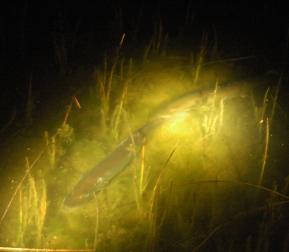Applying research agendas to sport fishing

Two adult muskie engage in their courtship dance in a northern Wisconsin lake. Courtesy of Joe Nohner/ MSU Center for Systems Integration and Sustainability
'Muskies and northern pike are the largest predatory fishes in this region, making them high-profile fisheries,' explained Joe Nohner, doctoral student in fisheries at the MSU Center for Systems Integration and Sustainability. 'By supporting strong pike and muskellunge populations, we can provide better fishing opportunities and a strong recreational fishing industry.'
Working with scientists from across the region, Nohner helped prioritize research and management needs for muskie and northern pike, including:
- Identifying and conserving the fishes' spawning habitats
- Improving knowledge and management of the effects of fishing on trophy-sized fish
- Understanding how stocking and fishing influence the genetic makeup of these fish populations
According to Nohner, most of the past research and management programs have focused on adult fish and protection from overfishing. While managers and anglers focus on adult fish populations, some fisheries have been undercut by declining natural reproduction. Fish populations have been kept up through stocking, so in many areas the fishery isn't self-sustaining.
'We believe we need a more holistic approach to managing these fishes,' Nohner said. 'We want to include genetics, habitat needs at all life stages, and include the effects of humans in the equation. It's somewhat daunting, but new technologies will help us meet the challenge.'
Nohner has started tackling part of the challenge himself, creating a computer mapping technique to predict the location of muskie spawning habitats.
By studying 28 lakes in northern Wisconsin, he and his colleague found that muskies preferred spawning in bays with moderately sloping lake bottoms and that the fish also preferred not to spawn along shorelines with houses or other development.
'Lakes with more development are less likely to be muskie spawning habitats,' Nohner said. 'Fisheries managers, county commissioners and lakeshore property owners may have to consider where development is located and how that will affect the fish.
'We found that muskie spawning site selection may be more complex than previously thought,' he continued. 'There is not just one particular characteristic that makes the fish gravitate to an area for spawning. There seem to be several factors that affect the location, which is why we need a modelling program to help identify those critical habitats.'
###
The paper 'Muskellunge and northern pike ecology and management: important issues and research needs' is published in the June issue of Fisheries. Besides Nohner, other authors are Derek Crane, John Farrell and Kevin Kapuscinski, of the State University of New York-Syracuse; Loren Miller, of the Minnesota Department of Natural Resources; James Diana, of the University of Michigan; and John Casselman, of Queen's University.
The paper 'Muskellunge spawning site selection in northern Wisconsin and a GIS-based predictive model' is published in the February issue of the North American journal of Fisheries Management. Nohner and Diana are the authors. The research was funded by the Wisconsin Department of Natural Resources, the Musky Clubs Alliance of Wisconsin, the University of Michigan and the Alvan Macauley Fellowship.
The Center for Systems Integration and Sustainability integrates ecology with socioeconomics, demography and other disciplines to conduct cutting-edge research on ecological sustainability on local, national and global scales.
Media Contact
All latest news from the category: Agricultural and Forestry Science
Newest articles

Superradiant atoms could push the boundaries of how precisely time can be measured
Superradiant atoms can help us measure time more precisely than ever. In a new study, researchers from the University of Copenhagen present a new method for measuring the time interval,…

Ion thermoelectric conversion devices for near room temperature
The electrode sheet of the thermoelectric device consists of ionic hydrogel, which is sandwiched between the electrodes to form, and the Prussian blue on the electrode undergoes a redox reaction…

Zap Energy achieves 37-million-degree temperatures in a compact device
New publication reports record electron temperatures for a small-scale, sheared-flow-stabilized Z-pinch fusion device. In the nine decades since humans first produced fusion reactions, only a few fusion technologies have demonstrated…





















